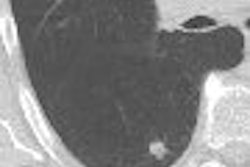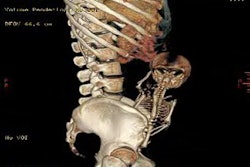Radiologists from the U.K. gave the edge to 2D primary reading in a study that compared it retrospectively to 3D for virtual colonoscopy interpretation.
While overall performance between the two methods was comparable, 3D yielded lower sensitivity and more false positives, and took significantly longer to complete. Meanwhile, a computer-aided reading scheme applied to both methods was helpful, according to a study in the June issue of Radiology.
It bears noting that the playing field wasn't exactly even, since the study compared 2D interpretation plus computer-assisted reading to 3D endoluminal viewing alone on a separate workstation. Moreover, the authors noted that the 3D workstation used in the study was different from the system used successfully in previous virtual colonoscopy studies.
"Advocates of the 3D endoluminal fly-through method suggest that it is less reader-intensive and that it appreciably increases the ease of polyp visualization," wrote the authors, including Dr. Stuart Taylor of St. Mark's Hospital and Dr. Steve Halligan from Charing Cross Hospital, both in London. "There is little evidence, however, that primary 2D analysis outperforms 3D analysis, and many radiologists believe that the 2D approach is considerably more time-efficient than the 3D approach" (Radiology, June 2006, Vol. 239: 3, pp. 759-767).
On the other hand, they wrote, computer-aided interpretation of polyps could be helpful for highlighting lesions that might be missed in 2D, thereby obviating some of the advantages of "a more time-consuming primary 3D analysis."
The study aimed to compare primary 3D viewing against primary 2D transverse analysis supplemented by computer-assisted reader (CAR) software for polyp visualization. A polyp-rich sample of 20 virtual colonoscopy datasets (comprising 14 men, median age 61) containing 48 colonoscopy-proven polyps was selected from five donor institutions. The studies had been acquired using prone and supine imaging, and 50-100 mAs and 120 kVp, save for two studies that used 200 mAs. Thirteen of 20 studies were fluid-tagged.
Two readers independently analyzed the datasets by primary 2D and 3D, and were blinded to the prevalence of abnormalities.
For the 2D primary reads, the studies were examined in consensus on a workstation equipped with computer-assisted reading software (ColonCAR 1.2, Medicsight, London), as well as multiplanar reformatted (MPR) images and endoluminal views available on demand.
The researchers differentiated Medicsight's CAR software used in the 2D review from computer-aided detection (CAD) schemes inasmuch as CAR is designed to highlight potential polyps, with complete user control over the degree of flatness and sphericity of detected objects. Default sphericity and flatness settings were used for the study.
For the 3D primary reads, the radiologists employed a separate workstation equipped with Vitrea 2 software (Vital Images, Plymouth, MN). Two-dimensional views were available for primary 3D interpretation and vice versa. Each reader read all the studies by both methods but reading was separated by a month's time, and the studies were randomized twice in efforts to reduce recall bias. The readers recorded their diagnostic confidence levels for both methods on a scale of 1 to 100, with 100 being the most confident.
Polyps were measured with electronic calipers, which were applied to the MPR image showing the greatest polyp dimension.
According to the results, mean sensitivity values for polyps measuring 1-5 mm, 6-9 mm, and 10 mm or larger were 14%, 53%, and 83%, respectively, for 2D plus CAD reading, and 16%, 53%, and 67%, respectively, for primary 3D analysis. There were no significant differences in reader confidence between 2D plus CAR (median 100; interquartile range 78.75-100) versus 3D (median 100; interquartile range 80-100).
Overall sensitivity was nearly the same: 41% for 2D plus CAD and 39% for the primary 3D analysis, the team wrote (p = 0.77). Importantly, the use of fluid tagging in half of the studies did not appear to affect sensitivity or specificity.
"Reader 1 detected significantly more polyps than reader 2 by using 2D analysis with CAR software (p = 0.04) and 3D endoluminal fly-through analysis (p = 0.002)," the team wrote. "Indeed, reader 2 detected only three of nine polyps measuring 10 mm or larger by using the 3D fly-through method compared with seven of nine polyps by using a 2D analysis with (CAD) software."
"Regarding the characteristics of polyps measuring 5 mm or larger that were detected on just one workstation, seven of eight were in close proximity to a fold, and five were highlighted by the CAR software," they added.
Average reading time was significantly less for 2D plus CAR (17.1 minutes ± 4.9) compared to primary 3D (mean 22.3 minutes ± 7.8). However, approximately two minutes spent loading studies into the CAR software were excluded from the calculations. There were no flat polyps in the data, and therefore the software was not challenged to look for them.
"In isolation the CAR software performed well, highlighting 76% of polyps 6-9 mm and all polyps larger than 10 mm," the group wrote. "On average, primary 3D analysis resulted in more than three times as many false-positive findings recorded by the readers, thereby suggesting that the erroneous CAR prompts did not unduly affect specificity."
The results showed that switching to primary endoluminal analysis is insufficient to compensate for inadequate 2D reader performance, the group noted, acknowledging the need for further investigation of the contribution of 2D imaging without CAR.
"We did not specifically investigate the additional benefit of 2D analysis with CAR software versus 2D analysis alone so we cannot be certain as to how much the CAR software contributed to reader performance," they noted. "Any incremental benefit of the CAR software was not the primary purpose of our study, and further research into this particular aspect is ongoing.... Concerning polyps that were identified by readers but were not prompted by the software, there was the suggestion that performance was better with 3D analysis than with 2D analysis."
Nevertheless, for the study as designed, "we found no advantage of using primary 3D endoluminal analysis versus 2D analysis supplemented by CAR software for either of our readers," they wrote. "Indeed, one reader detected less than half the number of polyps 10 mm or larger when using the 3D fly-through method.... Primary 2D analysis supplemented by computer-assisted reader software is quicker than and as sensitive as primary 3D fly-through analysis for polyp detection...."
By Eric Barnes
AuntMinnie.com staff writer
July 11, 2006
Related Reading
VC software highlights colon's unseen areas, June 16, 2006
New VC reading schemes could solve old problems, October 13, 2005
CAD aids polyp detection in 64-slice study, May 12, 2006
'Filet view' VC software slices reading time, October 6, 2005
VC CAD improves results for readers at all levels, April 7, 2006
Copyright © 2006 AuntMinnie.com



















